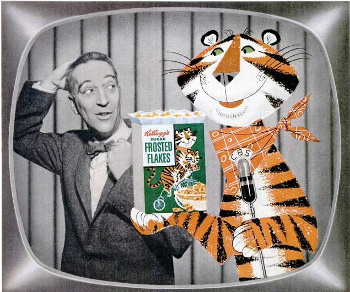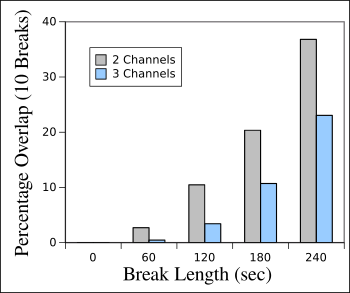Too Many Commercials
July 22, 2019
This article is about a
computer simulation of the
frequency of
television commercials. As the few of us who still watch
commercial television will readily attest, there are far too many commercials.
Adding insult to injury,
cable television subscribers are actually paying money to watch these commercials. The
public television channels have their frequent
begathons instead of actual commercials. It's no wonder why "
cord-cutting" has accelerated, and people are migrating to commercial-free
streamed content.
Except for some
regulations on
children's programming, there are no rules in the
United States regarding the percentage of time in which commercials are aired. The
Children's Television Act of 1990 limits commercials on children's programming to 10.5 minutes per hour on
weekends, and 12 minutes on
weekdays.[1] This is another example of the "
think of the children"
cliché in which congress readily enacts
child-protection laws but ignores similar problems in other areas. Aside from the Children's Television Act, there seems to be a serious disconnect between
reality and the
idea that the
public airwaves are
licensed to operators presumed to act in the
public interest.

Gary Moore, a popular television host during the 1950s, with Tony the Tiger, the Kellogg's Cereal character.
This print ad in the October 3, 1955, issue of Life magazine, has an image that simulates a television screen of that era.
Television was black-and-white in the 1950s, so Moore is in grayscale, while Tony the Tiger is surprisingly in color. (Via Wikimedia Commons)
It's estimated that commercial content presently fills more than fifteen minutes in an hour, but things weren't always this bleak. From 1952-1982, the
National Association of Broadcasters (NAB) had a
Code of Practices for Television Broadcasters that limited its
network-affiliated stations to 10 minutes of commercials and
promotional announcements per hour in so-called
prime time, and 16 minutes per hour at all other times. Unfortunately, this standard was declared
illegal in 1982,[2] and the
floodgates were opened.
My
family's own cord-cutting proceeded in stages. As our enjoyment of cable television decreased and its
cost increased over the years, we kept migrating to lower
tiers of channels until we were finally at a level that contained about thirty channels local to the
New York metropolitan market. We settled on this package only because we were able to receive these channels without
set-top boxes. As everyone has noticed, set-top box
rental charges are outrageous. While the cable company was loathe to admit it, those local channels were supplied as
QAM signals that modern television sets can decode and display.
About two years ago,
our television provider upgraded its
network to eliminate the QAM signals, so these channels could no longer be received without a set-top box. At that point, we dumped this costly means of obtaining limited content and went with the few
over-the-air (OTA) signals we could receive, plus
Internet streaming. The commercial-free content from the streamed services has made me more critical of the number of commercials on the OTA channels, so I became addicted to the "previous channel" button on my
television remote. Using this button, I could watch some interesting content on one channel while waiting for commercials to end on another.
I was finding that my previous channel option wasn't effective some of the time, since there were commercials on both channels. At one point I even added a third channel into the queue only to find commercials on that channel as well. It was at that point that I realized that seeing commercials simultaneously on all three channels was a consequence of the large fraction of time taken by commercials, and that this
phenomenon was a good problem for a
computer simulation.
Like most
computer people, I always jump to a
keyboard rather than exerting
brain power in discovering an
analytical solution. I this case, however, an analytical solution is easy. If there are ten, two-minute commercial breaks in an hour, the
probability of getting a commercial on a single channel is just 20/60 = 1/3 = 33.3%. To simultaneously get commercials on two channels, we have a probability of (1/3)x(1/3) = 1/9 = 11.1%, etc. This gives us a good idea of the general trend, but a simulation gives us the
distribution of values to show us how bad things can get for a specific trial.
My computer simulation (source code
here) bases its calculations on the number of station being watched, the number of commercial breaks in a programmed hour, and the length of each such commercial break. The times for such breaks are
randomized for each channel; but, for simplicity, the number and length are the same. The simulation runs through many random trials to discover the percentage of time that all these stations will be showing commercials at the same time.
We appear to be in a
regime in which commercials occupy 20 minutes of each hour, so it's interesting to see what the simulation shows when surf between two channels that serve ten commercial breaks of 120 seconds each. The following histogram shows the distribution of overlap of commercials between these two channels.

Histogram showing the percentage distribution of commercial overlap for two channels having ten breaks of two minutes each hour.
The mean is 10.47%, and the standard deviation is 3.44%.
While surfing between these two channels, there are quite a few occasions when simultaneous commercials occur 15% of the time; but, we can be lucky and have nearly no overlap. (Graphed using Gnumeric. Click for larger image.)
Surfing through three channels helps quite a bit, as the chart below shows. You can find commercial-free content about 95% of the time if the stations don't air more than 20 minutes of commercials an hour.

Commercial overlaps for two and three channels for the condition of ten two-minute commercial breaks per hour.
I must be pessimistic, since I also modeled the case of ten four-minute commercial breaks per hour; that is, forty minutes of commercials per hour.
Forty minutes is bad, but it's better than an hour's long infomercial for some medical nostrum.
(Graphed using Gnumeric.)
This bring us to the question of how effective is all this advertising. I think that there are so many commercials because the effectiveness rate per commercial is small. It's also a losing game, since adding commercial minutes to the hour just dilutes the impact of any individual commercial.
I'm rarely influenced by the commercials that I see, but there was one commercial that prompted my
wife and me during my
graduate school days to immediately exit our
apartment and make a purchase. This was the
Carly Simon "
Anticipation" commercial for
Heinz Ketchup, as shown below.[3] Unfortunately for Heinz, our purchase wasn't
ketchup. We rushed to a nearby
fast food restaurant for
hamburgers. Viewing the commercial will show you why.
References:
- Program Content Regulations, Federal Communications Commission Website.
- United States v. National Ass'n of Broadcasters, 553 F. Supp. 621 (D.D.C. 1982), UNITED STATES of America, Plaintiff, v.
NATIONAL ASSOCIATION OF BROADCASTERS, Defendant. Civ. A. No. 79-1549, United States District Court, District of Columbia, November 23, 1982, HAROLD H. GREENE, District Judge..
- Retro Heinz Ketchup Commercial - 1973 - 1st dinner in apartment, YouTube Video by upfront27, April 15, 2015.
Linked Keywords: Computer simulation; frequency; television advertisement; television commercial; commercial broadcasting; commercial television; adding insult to injury; cable television; subscription business model; subscriber; public broadcasting; public television; pledge drive; begathon; cord-cutting; streaming media; stream; regulation; children; United States; Children's Television Act of 1990; weekend; weekday; think of the children; cliché; child-protection; legislation; law; reality; idea; public; radio spectrum; airwaves; Federal Communications Commission; license; public interest; Gary Moore; television presenter; television host; 1950s; Tony the Tiger; Kellogg's Cereal; character (arts); advertising; print ad; Life magazine; television set; television screen; black-and-white; grayscale; color; Wikimedia Commons; National Association of Broadcasters (NAB); Code of Practices for Television Broadcasters; network-affiliate; promo (media); promotional announcement; prime time; illegal; floodgate; family; cost; ranking; tier; New York metropolitan area; media market; set-top box; rental charge; Quadrature amplitude modulation; QAM signal; Verizon Fios; television provider; telecommunications network; terrestrial television; over-the-air (OTA) signal; streaming media; Internet streaming; remote control; television remote; phenomenon; programmer; computer person; computer keyboard; brain power; analytical solution; probability; probability distribution; TV_commercials.c; randomness; randomize; regime; channel surfing; Gnumeric; pessimism; pessimistic; model; infomercial; patent medicine; medical nostrum; wife; graduate school; apartment; Carly Simon; Anticipation (song); Heinz Tomato Ketchup; ketchup; fast food restaurant; hamburger.